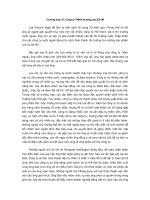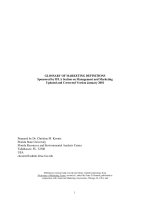Updated im c3 12345r223r2
Bạn đang xem bản rút gọn của tài liệu. Xem và tải ngay bản đầy đủ của tài liệu tại đây (2.87 MB, 30 trang )
CHAPTER 3
INTERNATIONAL MARKET SELECTION
VTHN
01 Segmentation process
04 Market selection process,
Regional, trans-na8onal
02 and global segments
05 Evalua8ng overall foreign
03 Global market segmentation
procedure, and strategy
market por=olios
1. MARKET SEGMENTATION
The process of classifying customers into homogeneous groups
with similar demand and/or preferences
(Bruning et al ., 2009, p. 1500)
A process whereby unique customer groups can be identified in
country-based/ individual consumer-based groups (Bruning et al .,
2009, p. 1500).
1 MARKET SEGMENTATION
- Interna(onally oriented firms largely depend on resource based
advantages, high quality products (tradi(on, chance, or produc(on
philosophy), and long-term personal rela(onships and commitment in
developing their niche strategies
- can generate specializa(on.
- involves costs, risks, and possible weaknesses
- analysis of market behavior: channels, customer segments, or use
occasions as well as the geographic dimension
2 SEGMENTATION SCENARIOS
Country segments
Regional segments
- Similarity across regional level
Transnational segments
- Segments based on similar needs across a group of countries
- Country clusters
Global Segments
- Segments transcending national boundaries with common needs
3 GLOBAL SEGMENTS
! “Homogeneous entities categorized by psychographic and behavioural similarities”
(Doole, Lowe & Kenyon, 2018)
! “.. defined based upon market variables other than national boundaries (Hassan, 2011)
! Share core values, attitudes and aspirations
! Recognition that world markets consist of similarities and differences as
distinguishing characteristics
! Segmentation across markets rather than within - consumers, not countries
! Problem if geographically spread
GLOBAL MARKET SEGMENTATION
“The process of identifying specific segments, whether they be country
groups or individual consumer groups, of potential customers with
homogeneous attributes who are likely to exhibit similar responses to a
company’s marketing mix”
(Hassan & Katsanis, 1991)
GLOBAL SEGMENTS
Teenagers
Affluent consumers
Technology geeks
Interna/onal
business travelers
Similarity of needs
depends on product
categories e.g. high-tech
consumer durables, travelrelated products
GLOBAL SEGMENTS
“Global consumers are
willing to put their money
where their heart is when
it comes to goods and
services from companies
committed to social
responsibility”
“China remains an engine
of growth for luxury goods
as the country’s middle
class con
power”
(Nielsen, 2014)
(Bain & Co, 2016)
“GLOBAL ELITE” SEGMENT
“Affluent consumers who are well travelled and have the money to
spend on pres6gious products with an image of exclusivity”
•
CHARACTERISTICS
•
•
•
Increased wealth
Well travelled
Prestige products universally
High quality products
GLOBAL TEEN SEGMENT
“Teenagers sharing memorable experiences which are reflected in their consumption
behavior. Young consumers whose cultural norms have not become ingrained and who
can share universal needs, wants and fantasies”
CHARACTERISTICS
- Internet
- Social media
- Interna0onal educa0on
- Frequent travel
- Apprecia0on of future trends, fashion and music
- Self- conscious about way they look
- Role models influence choices
- Music important communica0ons tool
GLOBAL TEEN SEGMENT
•
•
•
As cultures converge, teenagers around the world become more similar
They use well-known global brands like iPhone, Facebook, Nike, YouTube,
Tiktok, Coca Cola …
They wear the same clothes and want to look and feel right…
GLOBAL KIDS
Are children around
the world becoming
more similar?
Watch TV/Netflix, play
computer games,
download films, go to
McDonalds/ KFC
International success of TV
programmes like
Teletubbies, Harry Potter
books and films, Nintendo
games, Disney
PSYCHOGRAPHIC SEGMENTATION
to group prospective, current or previous customers by their shared
personality traits, beliefs, values, attitudes, interests, and lifestyles
and other factors”
Porsche Example
●
●
●
●
●
Top Guns (27%) an ambi3ous & driven individual who cares about power & control
Eli3sts (24%) individual from old money (blue blood), car is just a car
Proud Patrons (23%) reward for hard work
Bon Vivants (17%) thrill seekers and jet seJers, excitement & adventure
Fantasists (9%) form of escape, does not care about impressing others
(Keegan & Green, 2015)
VALS SEGMENTATION
(Values – A4tudes – Lifestyles)
HIGH RESOURCES
Innovators
Thinkers
Achievers
Experiencers
LOW RESOURCES
Believers
Strivers
Makers
Survivors
GLOBAL, LOCAL & FOREIGN
Global Consumer Culture
Posi
consumer culture
Local Consumer Culture
Posi
portrayed as an intrinsic
part of local culture
Foreign Consumer Culture
Positioning (FCCP)
Build brand mystique
around specific foreign
culture, usually with
positive connotations
“The fact that pizza-loving consumers are found in many countries does
not mean they are eating the exact same thing.” (Keegan & Green, 2008)
“Globalization will probably never reduce the complex human system to
a state of homogeneity” (Rugimbana & Nwankwo, 2003)
TRENDS INFLUENCING GLOBAL CONSUMPTION
- Spread of global consumer culture
- Global flow of dis8nc8ve, cultural resources
- Increases in GNP per capita
- Rise in life expectancy
- Increase in educa8on & literacy levels
- Growth in urbaniza8on in developing countries
- Advances in transporta8on and communica8ons
- World travel
- Global acceptance of certain consumer products (beverages,
fast food, fashion, cars, electronics)
GLOBAL CONSUMPTION TRENDS IN 2022
4.1 MARKET SELECTION PROCESS
Reactive approaches
Proactive approaches
passive, informal, unsystematic,
responding to situation, used by small
and medium-sized exporters, short
term profit motive
ac:ve in ini:a:ng market
selec:on, formal process
influencing factors
- Psychic distance – feeling of uncertainty about foreign
markets, perceived difficulty of finding informa:on
- Cultural distance – the perceived differences between the
manager’s own and the des:na:on culture
- Geographic distance – proximity.
4.2 MARKET SELECTION PROCEDURES
Expansive methods
home market starting point, based on
similarities and experience, use of
market clusters selection
Contractible methods
optimal market selection, starts with
large number, systematic screening
leading to elimination
4.2 MARKET SELECTION PROCEDURES
3 stages of ContracDble methods
1. Preliminary screening criteria for examining countries are iden3fied
(feasible countries)
2. Determines country characteris3cs in evalua3ng marke3ng opportuni3es and
how each should be weighted (opera3ng risks, market poten3al, costs, and
poten3al local and foreign compe33on)
3. Ranking of markets on the basis of scores derived
Step 1: Geographic segmentation
→
→
⤑
Estimation of sales potentials
Markets
Segments
→
→
Strategic planning
⤑
⤑
General market indicators
Product-specific market indicators
Prohibitive product
characteristics
Prohibitive market characteristics
Estimation of market potentials→⇢
Social-economic segmentation
Demand patterns
Quantitative indicators
Qualitative indicators
Supply patterns
Competition
Distribution
Media
⤑
Potential markets screening
EsAmaAon of profitability
Ranking of markets/ segments
Final market selecAon
Potential markets screening
Step 2: Customer segmenta1on
On the demand side behavior, lifestyle, attitudes, buying patterns, and decisionmaking must be included for both consumer and industrial markets
On the supply side
- competitors nationalities, capacities, activities
- distribution channels characteristics availability,
capacities, and activities performed
- media situation availability, costs, circulation, and
priorities.
Step 1 + 2 → estimate market share, estimate profitability
4.2 MARKET SELECTION PROCEDURES
Market spreading
●
●
●
●
Alloca'ng resources over large
number of markets
Fast growth rate at early stages
of expansion
Focus on reducing risk
Can create entry barriers to
compe'tors
Market concentraAon
●
●
●
●
Channelling resources into small
number of markets
Devo'ng high levels of marke'ng
effort & resources to each market
Slow and gradual expansion to
other countries or segments
More intensive development can
create higher market shares and
strong compe''ve posi'on









